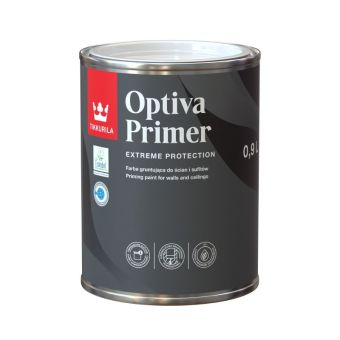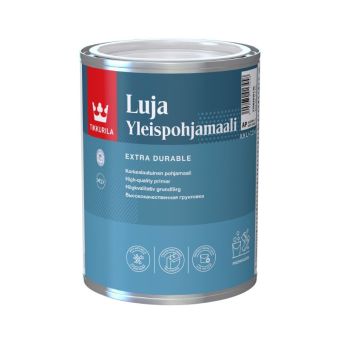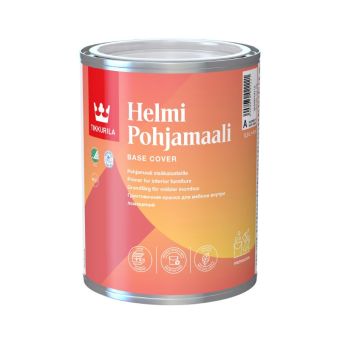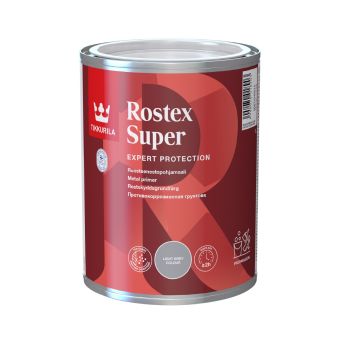What is paint primer and what does it do?
Primer paint contains special adhesives to stick to their designed surface and to create a smooth surface for the topcoat. Primer helps your paint to last longer, covers blemishes, fills in scratches, and prevents paint from chipping, peeling, or discolouring. If you are making a drastic colour change, for example from a dark to a light colour, the primer has properties that will help mask the colour beneath before applying the topcoat. Opting for a primer is a fail-safe way to achieve the perfect finish.
Primers are available for different types of surfaces, including hardwoods, softwoods, metal, drywall, and concrete. Each one contains a special adhesive created to stick best to that surface. This is incredibly helpful when painting some surfaces. If you are painting outside, you need a primer that can protect your surfaces from the elements. A primer will help materials such as wood or metal to withstand moisture and use. Many primers can be used on both interior and exterior surfaces, but don't forget to check before purchasing.
Do I need to prime every time I repaint or freshen my paint?
No, you don’t necessarily need to use a primer every time you repaint or freshen your paint. If your walls are clean and have minimal damage and chipping then a primer is not needed, especially if painting the same colour or a similar one.
If you're tackling a painting project and you're not sure if you need a primer, please give our technical team a call on 0131 334 4999 or send a message here.
What is the difference between undercoat and primer paint?
Primers are designed according to whichever surface type they are intended for. They have chemical ingredients to help reduce odours, mould, rust, and block stains.
Undercoats are simply a prepping layer without properties to protect the surface or improve adhesion.
Professionals would advise using a coat of primer or undercoat before applying your desired colour for the best results. Primer and undercoat cannot be used instead of topcoat paint.
What is the difference between the types of primer?
Water-based primers: Can be used on interior or exterior walls, but are preferred for indoor use. These primers are quick-drying and do not contain any solvents or strong odours. For this reason, the vast majority of Tikkurila's primers are water-based.
Best-selling water-based primers
Oil-based primers: Can be used on interior or exterior surfaces, but preferred for outdoor use. They do contain stronger chemicals that require proper ventilation when used. We still hold a small range of solvent-based primers as they offer excellent performance when painting extremely tricky surfaces. These products are; Otex Adhesion (for difficult surfaces eg. laminate) and Rostex Super (for metal surfaces).
Coloured Primers
Using a coloured primer will neutralise the colour of an existing surface helping to achieve the desired result with fewer coats. A coloured primer is particularly essential when painting with bold colours such as dark blues or greens, as without it more coats will usually be needed to achieve a deep, opaque finish.
When choosing the primer shade, the best result can be achieved when the primer shade is from the same colour family. Tikkurila have created a full range of primer shades designed to help achieve maximum opacity of the topcoat.
Top tip: If you're not sure which base to use, you can order your primer in the same colour as your topcoat. When ordering your primer, simply enter your preferred topcoat colour code into the free text box.
*Please keep in mind that a dark primer paint will appear much lighter than the digital swatch or subsequent topcoat paint. Don't be alarmed; this is normal! The final colour will be as expected after applying your topcoat.
For priming walls, we recommend using Optiva Primer. For woodwork, Helmi Primer or Otex Akva. These primers can be tinted to a wide range of colours. If you're not sure which primer is best for your surface, please give our technical team a call on 0131 334 4999 or send a message here.
How to prepare an interior plaster wall for primer
1. Remove any outlet coverts or light switch plates and fill in any holes.
2. Use very fine grit sandpaper on any holes that were filled or any spots that need to be smoothed out.
3. If any mould is present, treat the area first. Do not paint over it.
4. Wash the walls with soap and water. Allow them to dry completely.
5. Protect any surfaces that are not being painted.
6. Use a paint roller and brush to apply primer to the walls.
Is the primer not sticking to your paintbrush or roller? For water-based primers moisten the brush or roller before inserting it into the primer, and solvent-based primers will stick better with a bit of paint thinner added to the primer.
How many coats of primer do I need?
It all depends on the surface and the type of transformation. If the colour is only slightly changing, then only one coat of primer will be sufficient. If a drastic colour change is desired, it may be necessary to apply two coats. Surfaces like bare wood or new plaster will need 2 coats of primer. Tinted primers can help reduce the number of coats.
Does primer cover stains?
Primer helps to cover stains by providing a barrier between the stain and paint. It can cover imperfections on walls that have been patched or repaired which also includes stains.
How long does primer take to dry?
Water-based (latex) primers can take only 30 minutes to a couple of hours before completely drying, making them an ideal choice for most DIY projects in the home. Solvent-based primers can take up to 24 hours or more, depending on humidity to completely dry.
Which primer should I use?
When choosing a primer, start by considering the type of material you are painting. Some materials require specific primers such as exterior metal surfaces or bare pine.
Primer for plaster (or drywalls)
Plaster is very porous and will require primer for the best results. We recommend using a water-based, acrylic primer that works on new or previously painted interior walls and ceilings, such as Optiva Primer. Plaster primer reduces the absorption of plaster allowing for even finishing coats. It is also very quick drying so you can easily finish your project over the weekend.
Learn more about painting new plaster.
Primer for metal surfaces
The type of metal surface and its current state will determine which primer is most suited for your painting job. Metal primers contain anti-corrosion and rust properties and have specifically designed adhesion to stick to shiny and smooth surfaces.
Metal primers come in oil and water bases which should be paired with their corresponding paint. We recommend using a water-based primer when painting interior metal surfaces, such as our Rostex Super Akva as it leaves less toxic fumes and dries quicker. Rostex Super Akva is suitable for zinc-coated steel, roughened aluminium, copper, brass, and stainless steel making it a great option for painting various metal surfaces of the home.
If you have any rusting metal furniture outside, with a little elbow grease you can bring your old rusted patio set back to life. First, clean the surface with soap and water, followed by using a wire brush to remove light rust. To smooth out the rest of the metal surface, use fine-grain sandpaper then finish up with a primer for exterior metal surfaces, like Rostex Super.
Primer for kitchens, bathrooms and damp, humid areas
Similarly to the paint used in humid and high traffic areas such as the kitchen and bathroom, the primer used needs to repel moisture. Luja Universal Primer is a full-matt, quick-drying solution and can be used in any humid space. The only exception to this rule is for freshly plastered chalky surfaces. Optiva Primer is always recommended for this substrate.
Primer for bare wood
Primer is incredibly beneficial when painting wood, due to wood’s porous nature. The high solids content of primer prepares the surface, filling in any gaps, cuts, and grain of the wood. Because primer has better adhesion than most paints, it sticks to wooden surfaces even better, resulting in a smoother and more even surface to paint on.
If softwoods, like pine, are painted without primer, the paint will bleed and leave blotches leaving an uneven finish. Unstained wood will need latex or water-based primer, while stained wood can benefit from a stain-blocking primer.
Hardwoods also benefit from primer as their natural grain can result in an uneven paint job that can break down faster. Oily woods can be difficult for paint adhesion so a primer helps greatly.
Painting with dark colours? We recommend using a coloured primer in the same or similar shade first. Using a tinted primer will require fewer coats and in turn less time to achieve the desired finish.
Read our guide to priming timber to choose the right primer for the job.
Primer for previously painted wood
Interior woodwork that has been previously painted can pose a problem because paint applied on top may not adhere to the surface.
If the old paint is in good condition, there is no need to prime it, and an undercoat will still provide a smoother finish before applying the topcoat.
If the paint is chalking, chipped, or has a glossy finish, use an adhesive primer after properly preparing the surface.
For a smooth paint job, sand lightly after the primer dries. Allow 24 hours for the primer to cure and completely dry before applying your topcoat to ensure effectiveness.
Primer for wallpaper - should I primer paint a wallpapered wall?
In some cases, primer can be used on wallpaper. If the wallpaper is difficult to remove, painting it may be an option; however, a primer will be required in this case to produce an adhesive surface for the paint. If you're working with peeling wallpaper or fabric-based wallpaper, it's best not to paint over it. Remove the wallpaper and prepare your wall for primer as described above.
Primer for glass, tiles, PVC and mixed material surfaces
There are some primers designed to work with different materials at once. Tikkurila's Otex Akva is our solution to priming difficult or tricky interior surfaces. This product can work as a primer or undercoat for new or previously painted surfaces including glass, tiles, PVC-plastic, wood, chipboard, and more.
Need a primer that is not only suitable for tricky surfaces but can also withstand adverse weather? Try our Otex Adhesion Primer - a primer that is suitable for exterior materials like window frames, doors and garden furniture.
Primer for exterior wood
When it comes to painting exterior wooden surfaces such as sheds, fences, windows, doors and furniture, you will need a primer that is able to not only help paint absorb into the wood but also protect from moisture and UV rays.
For bare wood, we recommend using a colourless priming oil. Try Valtti Primer - a traditional priming oil designed specifically for untreated timber, containing water-repelling properties as well as providing protection against microbial and insect attack. If you are looking for a coloured finish, Valtti Primer can be overcoated with stains and opaque topcoats.
If your wooden surface has been previously painted, prime it with our Ultra Primer; a high-performance primer that offers a durable matt finish. Available in a wide range of colours for high coverage, opaque look to your garden surfaces.
Read our guide to priming timber to choose the right primer for the job.
Looking to paint your decking? Priming won't be necessary if you use a suitable decking oil. It will prevent wood fibres from raising, wood fading and cracking through weathering. Read more about painting exterior decking and terrace here.























